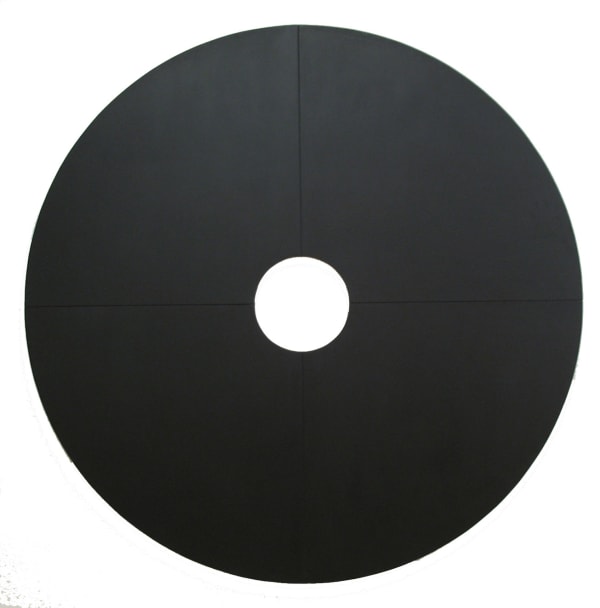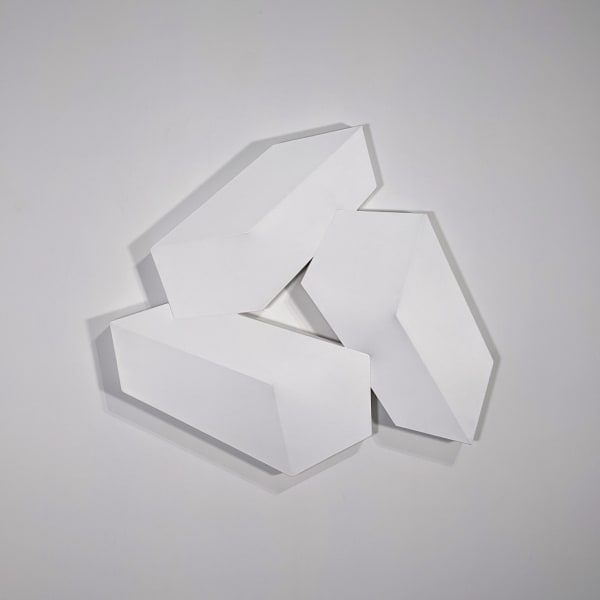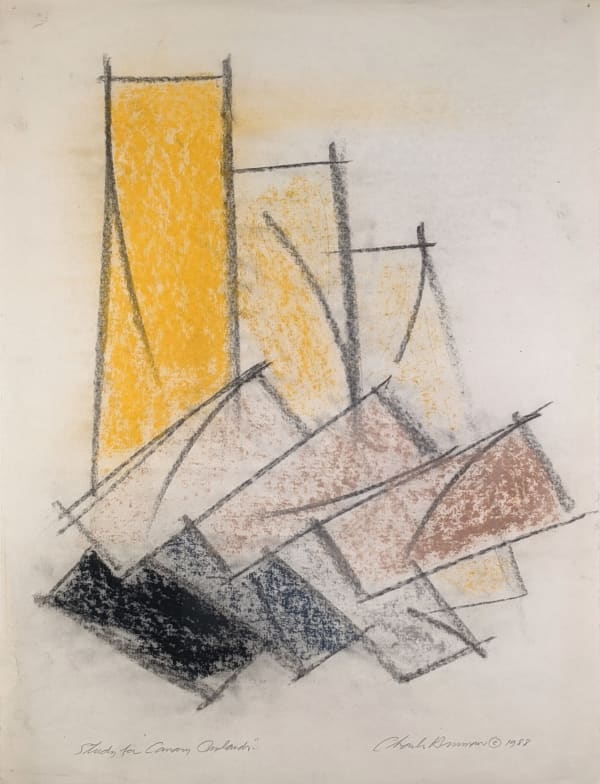WESTWOOD GALLERY NYC presents Structural Abstraction on the Bowery, a two-person exhibition of New York artists Charles Hinman (b. 1932) and Will Insley (1929–2011). On view are ten works—including shaped paintings and studies on paper—that trace the parallel yet divergent trajectories of two artists who, for fifty years, lived and worked in the same Bowery building while expanding the language of abstraction.
Emerging in the 1960s, Hinman and Insley were central to the development of Shaped Painting, a movement that redefined the boundaries between painting, sculpture, and architecture. Both artists participated in the landmark 1965 Shape and Structure exhibition at Tibor de Nagy Gallery alongside Donald Judd and Robert Morris, cementing their place within the avant-garde. Hinman’s mathematically precise constructions push painting into sculptural space through his concept of six dimensions—space, time, light, and color—while Insley’s diagrammatic Wall Fragments form part of his visionary ONECITY, a theoretical metropolis conceived through art and architecture.
Presented together, their works reveal contrasting philosophies—Hinman’s dynamic engagement with perception and form, Insley’s conceptual exploration of infinite structures—united by a commitment to structural innovation and the Bowery as their shared ground.
-
 Will Insley, Wall Fragment 64.6, Wind, 1964
Will Insley, Wall Fragment 64.6, Wind, 1964 -
 Will Insley, Wall Fragment 68.7, Ruler, 1968
Will Insley, Wall Fragment 68.7, Ruler, 1968 -
 Will Insley, Wall Fragment No. 67.7, Ring, 1967
Will Insley, Wall Fragment No. 67.7, Ring, 1967 -
 Will Insley, Wall Fragment 64.A, 1964
Will Insley, Wall Fragment 64.A, 1964
-
 Structural Abstraction on the Bowery | Installation View
Structural Abstraction on the Bowery | Installation View -
 Structural Abstraction on the Bowery | Installation View
Structural Abstraction on the Bowery | Installation View -
 Structural Abstraction on the Bowery | Installation View
Structural Abstraction on the Bowery | Installation View -
 Structural Abstraction on the Bowery | Installation View
Structural Abstraction on the Bowery | Installation View -
 Structural Abstraction on the Bowery | Installation View
Structural Abstraction on the Bowery | Installation View -
 Structural Abstraction on the Bowery | Installation View
Structural Abstraction on the Bowery | Installation View
WESTWOOD GALLERY NYC presented a two-person exhibition by New York artists Charles Hinman (b. 1932) and Will Insley (1929-2011), entitled Structural Abstraction on the Bowery. The artwork on exhibit highlighted the parallel development of two artists who created frontiers in the history of the art world. Both artists happened to live in the same building 231A Bowery for fifty years, each working on structural, conceptual, and abstract artwork. On view in the exhibition were ten works of art including four paintings by Will Insley, four paintings by Charles Hinman, and two studies on paper, one by each artist. Structural Abstraction on the Bowery was on view May 22 – July 31, 2021.
In the 1960s, many New York artists began to move toward geometric abstraction and minimal art as a reaction against the preceding Abstract Expressionist movement of the 1950s. Progressing with the use of logistical principles, formulation and concept, artists began to push painting into real space and three-dimensional form, and soon developed the Shaped Painting movement in a variety of styles including Hard-Edge, Color Field, Op, Pop, Conceptualism, and Minimalism. Shaped paintings gave architectural structure to canvases and allowed for the exploration of time, light, and color in dimensional space. The importance of the movement was further cemented by a seminal group exhibition at Tibor de Nagy Gallery in 1965 entitled “Shape and Structure,” curated by Frank Stella and Henry Geldzahler, which included shaped paintings by Charles Hinman, Will Insley, and Larry Bell alongside non-objective sculptures by Donald Judd, Robert Morris, Carl Andre, and Robert Murray. From the exhibition, MoMA purchased Hinman’s 8x5-foot Poltergeist (1964) for its permanent collection.
From the beginning of their careers, Charles Hinman and Will Insley’s work was conceived from two very different schools of thought. Hinman talks of the six dimensions of his paintings: “My concept of my work is dynamic---never static. I think of my paintings as occupying a 6-dimensional space: the three dimensions of space, one each of time, light, and color.” While Insley regards eight dimensions through his paintings and abstracted art-architecture: “It is believed that there is a series of eight shells in a structure referred to as the Eight Dimension Spiral and it is through this spiral that the journey of all death beyond human concept passes.” Both artists’ processes resulted in shaped structural artwork.
Charles Hinman’s mathematically elaborate wood stretchers and canvas accentuate the boundaries between sculptural and illusory spaces. On view in the exhibition, Aeolus (1989) is a grand all-white painting reaching ten-feet high that is reminiscent of the Greek god of the winds and inspired by Hinman’s early years working in his shared studio with James Rosenquist at an abandoned sail factory in Lower Manhattan’s Coenties Slip.
In contrast, Will Insley’s paintings explore the conceptual beginnings of his lifelong artistic endeavor ONECITY, a theoretical civilization and labyrinthine metropolis existing in the central North American plains. In his ‘Wall Fragment’ paintings featured in the exhibition, the artist created fragmented objects from an architectural and pictorial context with inner investigations through extensive writing in unpublished journals. On view in the first gallery section, Wall Fragment 64.6, Wind (1964) is a wheel of four black triangles with identical yellow grid bars meeting at right angles around a central opening, an early representation of paintings by Insley that utilize diagrammatic systems to fragments from the mind and of the walls of ONECITY. The interior space of the 'Wall Fragment' paintings is equivalent to the birth of each painting, as the origin of the artist's thoughts.
On the main gallery wall, two 1960s paintings by Insley and Hinman hang in dialogue with one another, expressing contradictions between real/illusory, positive/negative, and relaxation/tension. In this context, Hinman’s Liberation (1964) is a composition of three colored rectangular modules tapered at their base and held in stasis by two cords and gravity. Meanwhile, Insley’s Wall Fragment 68.7, Ruler (1968) is a fragment of invisible art-architecture measured into eighteen equivalent rectangles of 8x16 inches in three primary colors. Created only four years apart, both works feature a method of measuring space, with Hinman’s spanning the two-dimensional geometry of the wall and Insley’s comprising the human element using 8 inches to represent the spread of a person’s hand. Despite their differences, both paintings become the wall, and the wall becomes an environment for each artist’s trajectory from geometry to their individual interests.
The third gallery section highlights Hinman’s Canary Islands (1988) and Insley’s Wall Fragment 67.7, Ring (1967), two paintings that juxtapose the freedom of curvilinear forms within the restraints of color. Additional works include two studies by both artists of works on view in the exhibition. James Cavello, Curator and gallery co-founder maintained a close gallery relationship with both artists and is committed to elevating their history and exposing their artwork to the public.


















